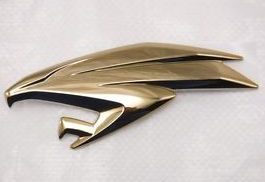The Toyota Harrier most likely resonates only with hardcore followers and fans of Japan’s largest automaker (including its Lexus marque) and regular Kaizen Factor readers. We wrote a pair of stories on the 3rd-generation (XU60) Harrier (on July 2013 and January 2015) primarily to debunk the widespread misconception that it was a thinly-veiled preview of the 4th-generation (AL20) Lexus RX. The latter’s debut 3 months after we posted our second story ended that nonsense, of course, but now the Harrier nameplate comes charging (or, perhaps, flying) back onto our radar for a very unexpected reason: its United States trademark filing by Toyota for “automobiles and structural parts thereof” on 2 August 2018 under Serial Number 88062919.
Perhaps (or even probably) this is only a corporate “housekeeping” legality and not a hint that the Harrier nameplate will, for the first time, be sold outside its native Japan. Yet, in our current crossover SUV-mad world, it is entirely conceivable that Toyota sees a niche for an additional crossover line that would join C-HR, RAV4 and Highlander in North American showrooms. Before we explore the possibilities, though, a little history and background is in order.
 What is a Harrier, anyway?
What is a Harrier, anyway?
According to Wikipedia‘s Toyota Harrier page,
The Harrier is named for the eastern marsh harrier, a bird of prey common to Hokkaidō and northern Honshū called the chuki in Japanese, and an emblem depicting the bird in stylized profile can be found on the grille.
 Early versions of the logo badge show the bird inside the typical Toyota/Lexus oval (as shown upper left), while in its latest 3rd-gen iteration (as shown lower left) the harrier is flying free, without the oval. It would be cool if this nice graphic logo would appear on potential export versions of the Harrier, but we’re not counting on it.
Early versions of the logo badge show the bird inside the typical Toyota/Lexus oval (as shown upper left), while in its latest 3rd-gen iteration (as shown lower left) the harrier is flying free, without the oval. It would be cool if this nice graphic logo would appear on potential export versions of the Harrier, but we’re not counting on it.
A brief history of the Toyota Harrier
We’ve already discussed the Toyota Harrier’s history in exhaustive detail in our previous 2013 and 2015 accounts, but, perhaps, a more succinct attempt to tell this convoluted story is in order.
 From early 1998 through late 2008, the first 2 generations of the Toyota Harrier and Lexus RX marched in lockstep as near-identical twins on Toyota’s largest (K) transverse-engined FWD-centric platform, with Harrier badging reserved for the Japanese Domestic Market and Lexus RX used for export versions. By the time of the November 2008 launch of the 3rd-generation RX, the Lexus marque had made its long-overdue appearance in Japan and iconic Toyota nameplates such as Celsior, Soarer, Aristo and Altezza had already given way to two-letter Lexus badging. The 2nd-gen (XU30) Harrier, on the other hand, soldiered on in Japan unchanged (albeit decontented and offered only with the 2AZ-FE 2.4-liter 4-cylinder engine) until July 2013, over a decade after its original February 2003 launch.
From early 1998 through late 2008, the first 2 generations of the Toyota Harrier and Lexus RX marched in lockstep as near-identical twins on Toyota’s largest (K) transverse-engined FWD-centric platform, with Harrier badging reserved for the Japanese Domestic Market and Lexus RX used for export versions. By the time of the November 2008 launch of the 3rd-generation RX, the Lexus marque had made its long-overdue appearance in Japan and iconic Toyota nameplates such as Celsior, Soarer, Aristo and Altezza had already given way to two-letter Lexus badging. The 2nd-gen (XU30) Harrier, on the other hand, soldiered on in Japan unchanged (albeit decontented and offered only with the 2AZ-FE 2.4-liter 4-cylinder engine) until July 2013, over a decade after its original February 2003 launch.
 Meanwhile, the Toyota brand’s seminal crossover, the RAV4 followed a roughly analogous strategy in Japan. Upon the launch of its 4th-gen (XA40) iteration in early 2013, this “new” RAV4 became an export-only model. Those wishing to purchase a RAV4 from Japanese new car showrooms were, instead, offered the short-wheelbase version of the “old” 3rd-gen XA30 until May 2016.
Meanwhile, the Toyota brand’s seminal crossover, the RAV4 followed a roughly analogous strategy in Japan. Upon the launch of its 4th-gen (XA40) iteration in early 2013, this “new” RAV4 became an export-only model. Those wishing to purchase a RAV4 from Japanese new car showrooms were, instead, offered the short-wheelbase version of the “old” 3rd-gen XA30 until May 2016.
In December 2013, a third generation of the Harrier was launched in Japan. It actually shrank versus its predecessor (the wheelbase by 2.2″/55mm and overall length by 1.4″/35mm) and moved from the larger K to the smaller “New MC” architecture shared with the outgoing RAV4 and Lexus NX. The new Harrier was positioned as a more upmarket alternative to the older “lame duck” Japanese RAV4, a fact further confirmed by its June 2017 mid-life refresh which saw revised trim levels (including a GR Sport variant) and the addition of an 8AR-FTS 2-liter 4-cylinder turbocharged engine option in addition to the previously-available 3ZR-FAE 2-liter naturally-aspirated four and the 2.5-liter 2AR-FXE hybrid.
With many Toyota product cycles in a state of flux, and the longer-than-average 3.5-year period between the 3rd-gen Harrier’s launch and midlife refresh, somewhere between the 2020 and 2021 model year is our best guess for the appearance of a hypothetical 4th-gen Harrier. This would, most likely, be built on the TNGA-K architecture.

What role would a 4th-generation Harrier fill?
For the record, perhaps we should mention Toyota’s most recent trio of concept crossovers: the FT-4X (a boxier, more offroad-ready country mouse to the C-HR’s city mouse), TJ Cruiser (a minivan/SUV mashup) and FT-AC (a butched-up predictor for the 5th-gen RAV4). Yet, none of them match the Harrier’s ethos of refined, car-like crossover with evolutionary styling and greenhouse design, in particular, that has barely changed over the past couple of generations. This, surely, is the root of all the “3rd-gen Harrier-as-4th-gen Lexus RX” confusion. At that point, few had really foreseen that the fourth RX would be such a clean styling break from its most recent predecessors.
If any gap appears in need of plugging in Toyota’s current North American lineup of crossovers, it’s that of a strictly 2-row, mid-sized model with sports-luxury aspirations but mass-market branding. You could say it’s the 21st-century take on the personal sports coupe category once exemplified by the Chevrolet Monte Carlo, Chrysler Sebring, Toyota Camry Solara and the Honda Accord Coupe, among others.
Nissan arguably kick-started this genre with the launch of the Murano back in mid-2002. Ford ably picked up the baton with its Edge, and Chevrolet and Honda are expected to join the fray early next year with two blast-from-the-past nameplates: Blazer and Passport, respectively.
 But wait, wasn’t Toyota already there once, with the Venza? Indeed, it was. I wrote a piece on its demise back in March 2015. Some pundits tend to blame its failure on its being too skewed towards the car end of the crossover spectrum, a charge also lobbed against its far gawkier but similarly star-crossed Honda Crosstour rival. The Venza’s Wikipedia page touches on that issue:
But wait, wasn’t Toyota already there once, with the Venza? Indeed, it was. I wrote a piece on its demise back in March 2015. Some pundits tend to blame its failure on its being too skewed towards the car end of the crossover spectrum, a charge also lobbed against its far gawkier but similarly star-crossed Honda Crosstour rival. The Venza’s Wikipedia page touches on that issue:
Determining whether the Venza is a crossover SUV or wagon isn’t clear; some journalists regard it as the “Camry station wagon”… while other sources often describe it simply as new type of “crossover”… According to Toyota, Venza is neither a station wagon nor SUV, rather it is targeted at customers who want more room and flexibility than the Camry sedan but desire a smaller size than the Highlander, a mid-size crossover SUV…
Toyota told automotive magazine Motor Trend that it forgo entering the Venza in the publication’s SUV of the Year competition. Toyota requested that the Venza compete in the Car of the Year competition. Motor Trend decided that the Venza should not compete in any competition at all since its ride height is too high to be qualified as a car.
This neither-fish-nor-fowl description reminds this author of yet another failed niche experiment: BMW’s 3-Series and 5-Series GT models that split the height difference between their sedan and X-series crossover counterparts.
If, indeed, a new Toyota Harrier is coming to America, perhaps starting with a clean slate, more clearly crossover styling and a new name will make it a more successful successor to the Venza.


Be First to Comment